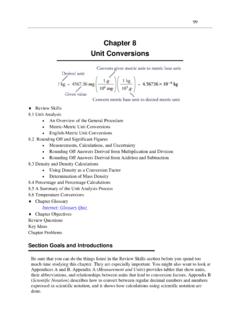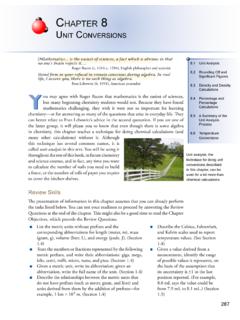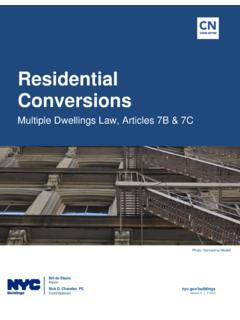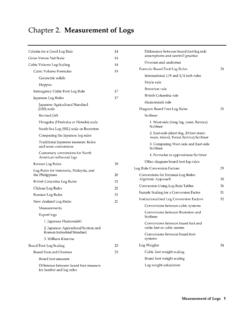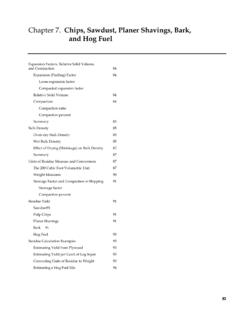Transcription of Loft Conversions and the Building Regulations
1 1 Loft conv Rev 2 2007 LOFT Conversions and the Building Regulations Simplified Guidance LOCAL AUTHORITY Building CONTROL SERVICES 2007 Loft conv Rev 2 2007 C O N T E N T S Page 1 Introduction 3 2 Design Considerations 4 3 Structural Stability 5 4 Fire Safety 8 5 Ventilation 16 6 Staircase Access 19 7 Thermal Insulation 23 8 Electrical Safety 24 9 Typical Problems and Solutions 25 10 Checklist 29 3 Loft conv Rev 2 2007 1 INTRODUCTION 1:1 This guidance booklet considers the extension of a typical 2 storey dwelling into a 3 storey unit , by the addition of a 'Loft conversion ' within the existing roof space.
2 It is not possible, nor is it intended that this booklet should cover every aspect of the design. Primarily, it's purpose is to highlight the basic design considerations which need to be addressed. Specific technical detail has largely been omitted due to the criteria being subject to frequent change. If the proposal involves the conversion of a loft space above a bungalow, the fire safety provisions indicated in section 4:00 are not applicable, other than the arrangement of inner rooms. 1:2 For the purposes of this guidance, it is assumed the proposed conversion will not: (a) exceed 50 m2 in floor area, (b) involve raising the roof line above the existing ridge level, and (c) contain more that two habitable rooms, on the new second storey.
3 1:3 When considering a loft conversion , contact must be made with the relevant Planning Authority to ascertain whether an application is required under the Town & Country Planning Act, Building Regulation consent will always be required. 1:4 The Party Wall Act, 1996, places certain obligations on you if you are going to carry out work which involves the party wall (that is the separating wall) if you live in a semi detached or terrace property. An advice leaflet on The Party Wall Act is available from the Council. 4 Loft conv Rev 2 2007 2 DESIGN CONSIDERATIONS 2:1 The booklet will examine what we consider to be the most important areas of the design, and those, which through experience, have caused problems during both the design and construction stages.
4 2:2 Structural Stability of the dwelling, considering both the existing structure and the proposed alterations, with reference to the supporting Approved Document A, of Schedule 1 to the Building Regulations . 2:3 Fire Safety of the proposed conversion with reference to the Approved Document B, of Schedule 1 to the Building Regulations . 2:4 Ventilation of the rooms and the control of condensation in roofs, with reference to the Approved Document C and F, of Schedule 1 to the Building Regulations . 2:5 Staircase provision to the new storey with reference to the Approved Document K, of Schedule 1 to the Building Regulations . 2:6 Thermal Insulation of the conversion with reference to the Approved Document L, of Schedule 1 to the Building Regulations .
5 3 STRUCTURAL STABILITY 5 Loft conv Rev 2 2007 3:1 In assessing the structural stability requirements, it is essential to consider the existing roof construction, new floor, and the impact the alterations will have on the structure. For the purpose of illustration and discussion, it is intended to concentrate on a typical 'cut' roof scenario involving purlins, rafters and ceiling joists as indicated in Diagram 1. Conversions in Trussed Rafter roofs, (used since the 1960's), will require additional structural considerations, and our advice to homeowners would be to consult a Structural Engineer early in the design process. 3:2 With regard to the roof, it is clearly advisable to construct the loft conversion with the minimum disruption to the existing structure.
6 The position of the purlins, if present, is a prime factor in determining the extent of the internal area, which can be achieved in the conversion . Diagram 2 indicates two typical arrangements. The existence of loadbearing walls at first floor level is an advantage in conversion works, in providing 6 Loft conv Rev 2 2007 support to loadbearing elements transferred from the roof, partitions, and the new floor. 3:3 In the majority of instances the existing ceiling joist member will be inadequate for the imposed loadings from the new floor construction. A commonly used solution is to provide new floor joists fixed alongside the existing ceiling joists, spanning from available loadbearing supports as indicated in Diagram 3.
7 The new floor joist should also be capable of supporting the existing ceiling particularly where binders are to be removed. Where the new floor joists are to carry roof load, as in Diagram 2(b), the floor joists need to be suitably designed. 7 Loft conv Rev 2 2007 3:4 Where the available height within the loft is at a premium, it is of benefit to restrict the depth of the section of the new floor joist to a minimum. This can be achieved by reducing the span of the joist where internal loadbearing walls permit, or using a higher strength classification timber, C24 in lieu of C16. 3:4:1 When considering the minimum depth of section permissible for the new floor joists, it is prudent to choose the section which offers the greatest resistance to deflection.
8 Although a lesser section at the limit of it's load / span capability may be more economic and unlikely to fail structurally, serious damage to a previously perfect plasterboard ceiling may occur when fixed along side the existing ceiling joist due to deflection. 8 Loft conv Rev 2 2007 4 FIRE SAFETY 4:1 MEANS OF ESCAPE IN CASE OF FIRE The addition of a third storey to a dwelling house introduces a greater risk to the occupants of that storey in the event of a fire occurring on either of the lower floors. Accordingly the Building Regulations require additional measures to ensure a safe means of escape is provided within the Building .
9 4:1:1 One of the principal requirements for means of escape, is the arrangement relating to the discharge of the existing staircase at ground floor level. Ideally, the staircase should lead directly to the front entrance door within the existing hallway as indicated in Diagram 4. Fire Door FD20 9 Loft conv Rev 2 2007 4:1:2 However, it is not uncommon to find existing layouts where the staircase discharges into a living room area. In this instance, it will be necessary to provide two escape routes at ground level, each leading to final exits and separated from each other by fire-resisting construction and self-closing fire doors as indicated in Diagram 5.
10 Alternatively, provide one protected escape route to a final exit similar to that shown in Diagram 4. 4:1:3 Having established a satisfactory arrangement at ground floor level, it is then necessary to consider how the route from the new third storey to ground floor can be protected to provide safe means of escape for the occupants. 4:1:4 The highest standard of 'passive' safety is achieved by providing a fully protected enclosure, achieving 30 minutes fire resistance, from the third storey to the final exit at ground floor level. This will involve assessing the performance of the walls and partitions to the staircase enclosure in addition to the floor construction, (guidance on upgrading floors to achieve 30 minutes fire resistance is contained in paragraphs 4:30 - 4:32, "Structural Fire Resistance").
